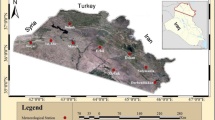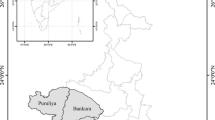Abstract
Agriculture in hill and mountain ecosystems is predominantly rainfed with common occurrence of moisture stress. It is a natural disaster which evolves in time and its impacts last for a long time. In the present investigation, long-term monthly precipitation data for 40 years (1980–2019) were used for characterizing agricultural drought in Almora and Nainital districts of Uttarakhand in India. Different drought indices based on meteorological data like standard precipitation index (SPI), percentage of departure (Pd) and percent of normal (Pn) were used. Percentage of departure is calculated from deviation of monthly precipitation from the long-term average monthly precipitation. Percent of normal is calculated by dividing the precipitation by normal precipitation for time being considered. SPI values were calculated based on gamma distribution of long-term monthly precipitation data. The Pearson’s correlation coefficient between monthly percentage of departure and different SPI time scales (1, 3 and 6 months) were analyzed. SPI-1 (July and August) for both the stations showed very strong correlation with the corresponding monthly percentage of departure (r > 0.97) than SPI-3 and SPI-6. Therefore, it is suggested that SPI as a stand-alone indicator should not be interpreted to identify drought in a hilly region.
Research highlights
-
Meteorological drought indices have been used to identify agricultural drought.
-
SPI-1 showed very strong correlation with percentage of departure.
-
Meteorological based SPI was well correlated with satellite based drought indices.
-
Study suggest to use multiple drought indices for drought Identification.













Similar content being viewed by others
References
Angelidis P, Maris F, Kotsovinos N and Hrissanthou V 2012 Computation of drought index SPI with alternative distribution functions; Water Resour. Manag. 26(9) 2453–2473.
Basistha A, Arya D S and Goel N K 2009 Analysis of historical changes in precipitation in the Indian Himalayas; Int. J. Climatol. 29 555–572.
Belayneh A, Adamowski J, Khalil B and Ozga-Zielinski B 2014 Long-term SPI drought forecasting in the Awash River Basin in Ethiopia using wavelet neural networks and wavelet support vector regression models; J. Hydrol. 508 418–429.
Bonsal B, Aider R, Gachon P and Lapp S 2013 An assessment of Canadian prairie drought: Past, present, and future; Clim. Dyn. 41 501–516.
Dutta D, Kundu A and Patel N R 2013 Predicting agricultural drought in eastern Rajasthan of India using NDVI and standardized precipitation index (SPI); Geocarto. Int. 28(3) 192–209.
Dogan S, Berktay A and Singh V 2012 Comparison of multi-monthly precipitation-based drought severity indices, with application to semi-arid Konya closed basin, Turkey; J. Hydrol. 470–471 255–268.
Edossa D C, Babel M S and Gupta A D 2010 Drought analysis in the Awash river basin, Ethiopia; Water Resour. Manag. 24(7) 1441–1460.
Edwards D C 1997 Characteristics of 20th-century drought in the United States at multiple time scales; Master of science dissertation submitted to the Department of Atmospheric Science, Colorado State University, Fort Collins, Colorado.
Guttman N B 1998 Comparing the palmer drought index and the standardized precipitation index; J. Am. Water Resour. Assoc. 34(1) 113–121.
Hayes M J, Svoboda M D, Wilhite D A and Vanyarkho O V 1999 Monitoring the 1996 drought using the standardized precipitation index; Bull. Am. Meteorol. Soc. 80(3) 429–438.
Hayes M J, Wilhite D A and Svoboda M D 2000 Monitoring drought using the standardized precipitation index; In: Drought: A Global Assessment (ed.) Wilhite D A, Routledge, London, UK, pp. 168–180.
Jain S K, Keshri R, Goswami A, Sarkar A and Chaudary A 2009 Identification of drought vulnerable areas using NOAA AVHRR data; Int. J. Remote Sens. 30(10) 2653–2668.
Jain V K, Pandey R P, Jain M K and Byun H R 2015 Comparison of drought indices for appraisal of drought characteristics in the Ken River Basin; Wea. Climate Extr. 8 1–11.
Kamble D B, Gautam S, Bisht H, Rawat S and Kundu A 2019 Drought assessment for Kharif rice using Standardized Precipitation Index (SPI) and Vegetation Condition Index (VCI); J. Agrometeorol. 21(2) 182–187.
Karavitis C A, Alexandris S, Tsesmelis D E and Athanasopoulos G 2011 Application of the Standardized Precipitation Index (SPI) in Greece; Water (Switzerland) 3(3) 787–805.
Keyantash J and Dracup J A 2002 The quantification of drought: An evaluation of drought indices; Bull. Am. Meteorol. Soc. 83(8) 1167–1180.
Kumar M N, Murthy C S, Sesha Sai M V R and Roy P S 2009 On the use of Standardized Precipitation Index (SPI) for drought intensity assessment; Meteorol. Appl. 16 381–389.
Kumar M N, Murthy C S, Sesha Sai M V R and Roy P S 2012 Spatiotemporal analysis of meteorological drought variability in the Indian region using standardized precipitation index; Meteorol. Appl. 19 256–264.
Kumar V, Shanu and Jahangeer 2017 Statistical distribution of precipitation in Uttarakhand, India; Appl. Water Sci. 7 4765–4776.
McKee T B, Doesken N J and Kleist J 1993 The relationship of drought frequency and duration to time scales; In: Proceedings of the IX Conference on Applied Climatology, Am. Meteorol. Soc. 17(22) 179–183.
Mishra A K and Singh V P 2009 Analysis of drought severity-area-frequency curves using a general circulation model and scenario uncertainty; J. Geophys. Res. 114 (D6).
Mishra A K and Singh V P 2010 A review of drought concepts; J. Hydrol. 391(1–2) 202–216.
Meshram S, Kant S and Sahu K C 2014 Identification of meteorological drought year for varnasi district, UP; Recent Res. Sci. Technol. 6(1) 245–247.
Morid S, Smakhtin V and Moghaddasi M 2006 Comparision of seven meteorological indices for drought monitoring in Iran; Int. J. Climatol. 26(7) 971–985.
Pai D S, Sridhar L, Guhathakurta P and Hatwar H R 2011 District-wide drought climatology of the southwest monsoon season over India based on standardized precipitation index (SPI); Nat. Hazards 59(3) 1797–1813.
Patel N R, Parida B R, Venus V, Saha S K and Dadhwal V K 2012 Analysis of agricultural drought using vegetation temperature condition index (VTCI) from Terra/MODIS satellite data; Environ. Monit. Assess. 184(12) 7153–7163.
Pashiardis S and Michaelides S 2008 Implementation of the standardized precipitation index (SPI) and the reconnaissance drought index (RDI) for regional drought assessment: A case study for Cyprus; European Water 23 57–65.
Pandey R P, Dash B B, Mishra S K and Singh R 2008 Study of indices for drought characterization in KBK districts in Orissa (India); Hydrol. Process. 22(12) 1895–1907.
Pandey R P, Pandey A, Galkate R V, Byun H R and Mal B C 2010 Integrating hydro-meteorological and physiographic factors for assessment of vulnerability to drought; Water Resour. Manag. 24(15) 4199–4217.
Patel N R, Chopra P and Dadhwal V K 2007 Analyzing spatial patterns of meteorological drought using standard precipitation index; Meteorol. Appl. 14(4) 329–336.
Poonia S and Rao A S 2012 Analysis of meteorological drought at arid Rajasthan using Standardized Precipitation Index; In: 92nd Am. Meteorol. Soc. Annual. Meet. (January 22–26, 2012).
Quiring S M and Ganesh S 2010 Evaluating the utility of the vegetation condition index (VCI) for monitoring meteorological drought in Texas; Agr. Forest Meteorol. 150(3) 330–339.
Rathore M S 2004 State-level analysis of drought policies and impacts in Rajasthan, India; International Water Management Institute, Paper 93.
Raziei T, Saghafian B, Paulo A A, Pereira L S and Bordi I 2009 Spatial patterns and temporal variability of drought in Western Iran; Water Resour. Manag. 23(3) 439–455.
Roudier P and Mahe G 2010 Study of water stress and droughts with indicators using daily data on the Bani River (Niger Basin, Mali). Int. J. Climatol. 30(11) 1689–1705.
Szalai S and Szinell C S 2000 Comparison of two drought indices for drought monitoring in Hungary – A case study; In: Drought and drought mitigation in Europe (eds) Vogt J V and Somma F, Adv. Nat. Technol. Hazards Res. 14, https://doi.org/10.1007/978-94-015-9472-1_12.
Santos J F, Portela M M and Pulido-Calvo I 2011 Regional frequency analysis of droughts in Portugal; Water Resour. Manag. 25(14) 3537–3558.
Sahu Y K, Mishra E P and Rawat S 2018 Quantification of crop water stress index (CWSI) for maize crop under different microclimatic conditions of Allahabad; J. Agrometeorol. 20 368–371.
Siddiqui A R 2004 Regional Evaluation of Desertification Hazards in the Aridlands of Western Rajasthan (an unpublished Ph. D. thesis), AMU, Aligarh, Uttar Pradesh, India, 221p.
Singh R B and Mal S 2014 Trend and variability of monsoon and other precipitation seasons in Western Himalaya, India; Atmos. Sci. Lett. 15 218–226.
Srivastava A, Kumari N and Maza M 2020 Hydrological Response to agricultural land use heterogeneity using variable infiltration capacity model; Water Resour. Manag. 34 3779–3794.
Srivastava A, Sahoo B, Raghuwanshi N S and Chatterjee C 2018 Modelling the dynamics of evapotranspiration using variable infiltration capacity model and regionally-calibrated Hargreaves approach; Irrig. Sci. 36 289–300.
Srivastava A, Sahoo B, Raghuwanshi N S and Singh R 2017 Evaluation of variable infiltration capacity model and MODIS terra satellite-derived grid-scale evapotranspiration estimates in a river basin with tropical monsoon-type climatology; J. Irrig. Drainage Eng. 143(8) 04017028.
Subramanya K 2005 Engineering Hydrology; Tata-Mcgraw Hill, New Delhi, India.
Tabrizi A A, Khalili D, Kamgar-Haghighi A A and Zand-Parsa S 2010 Utilization of time-based meteorological droughts to investigate occurrence of streamflow droughts; Water Resour. Manag. 24(15) 4287–4306.
Zin W Z W, Jemain A A and Ibrahim K 2013 Analysis of drought condition and risk in Peninsular Malaysia using Standardised Precipitation Index; Theor. Appl. Climatol. 111(3–4) 559–568.
Zhai J, Su B, Krysanova V, Vetter T, Gao C and Jiang T 2010 Spatial variation and trends in PDSI and SPI indices and their relation to streamflow in 10 large regions of China; J. Climate 23(3) 649–663.
Zhang A and Jia G 2013 Monitoring meteorological drought in semiarid regions using multi-sensor microwave remote sensing data; Remote Sens. Env. 134 12–23.
Acknowledgements
Authors are thankful to all the field and laboratory staff for their help in this study. We are very much thankful to the ICAR-VPKAS, Almora as well as ICAR, New Delhi for providing financial support during the course of investigation.
Author information
Authors and Affiliations
Contributions
UK did the modelling exercise with the help of SS, and prepared the manuscript with contributions from all the co-authors. UK along with SS performed the research, literature survey, result interpretation, and manuscript revision during peer-review process. UK and SS conceptualized and supervised the entire research and arranged the necessary data and resources. JKB and LK reviewed the first draft and provided inputs for improvement.
Corresponding author
Additional information
Communicated by Parthasarathi Mukhopadhyay
Rights and permissions
About this article
Cite this article
Kumar, U., Singh, S., Bisht, J.K. et al. Use of meteorological data for identification of agricultural drought in Kumaon region of Uttarakhand. J Earth Syst Sci 130, 121 (2021). https://doi.org/10.1007/s12040-021-01622-1
Received:
Revised:
Accepted:
Published:
DOI: https://doi.org/10.1007/s12040-021-01622-1




